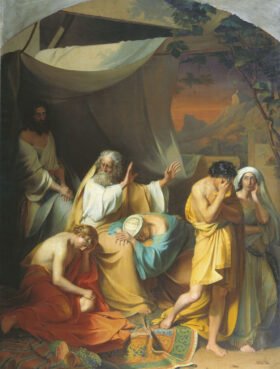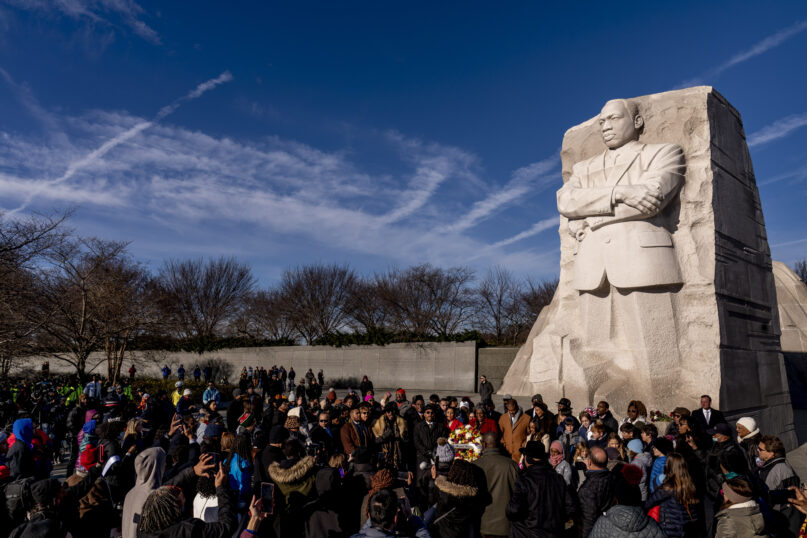(RNS) — On this week when we celebrate the legacy of Martin Luther King Jr., and with rates of antisemitism and racism on the rise, it’s important to reassert the common roots of hatred directed against both Blacks and Jews. At a time when we also see the terrible psychological blow Oct. 7 has taken on Jews everywhere, and the continuing efforts of white supremacists to attack and divide, we need to redouble efforts to cultivate that common ground.
We share the heritage of the Bible, which has been used to inspire and at times to subjugate both groups. The subjugation part begins with a Great Lie based on the Noah story, called the “Curse of Ham,” which was perpetuated by medieval haters attempting to lend biblical backing to their racist aims.
In Genesis 9, after leaving the ark with his sons Shem, Ham and Yafet, Noah plants a vineyard, a symbol of the survivor’s instinct, which eventually leads to a remarkable discovery: wine. Noah gets drunk and goes a little crazy. The text then continues:
Ham, the father of Canaan, saw the nakedness of his father, and went outside and told his two brethren. …
His brothers then cover their father with a garment and look askance so as not to shame him, another instinctive and quintessentially human endeavor, to protect the dignity of a loved one, affirming Noah’s worth as a human being.
Noah wakes up, sees what’s happened, goes ballistic and, for some inexplicable reason, curses Ham’s son, Canaan.
And he said: Cursed be Canaan; a servant of servants shall he be unto his brethren.
Noah then blesses his two other sons and says that Canaan will be the servant of Shem.
This has come to be called the Curse of Ham, which since the Middle Ages has been used to justify the enslavement of Black Africans, since Ham was said to have inhabited that continent. In 1578, English travel writer George Best wrote that it was God’s will that Ham’s son and “all his posteritie after him should be so blacke and loathesome that it might be a spectacle of disobedience to all the worlde.”
In the popular imagination, blackness itself became the curse. Slavery was the byproduct. In subsequent centuries, the curse quickly gained the sanction of the church.
As Ibram X. Kendi writes in his recent books detailing the history of racism, the Bible was used as a pretext to justify the horrible things that were already happening. Exploitation came first, the biblical foundation for racist ideology came second. Kendi writes:
The same Bible that taught me that all humans descended from the first pair also argued for immutable human difference, the result of a divine curse.
Here are a couple of Jewish things you need to know about the Curse of Ham and Canaan.

“Noah Damning Ham,” a 19th-century painting by Ivan Stepanovich Ksenofontov. (Image courtesy of Wikipedia/Creative Commons)
First, even in the Jewish sources that see the curse in terms of skin color, no value judgment is made here as to which color is superior. One midrash (Pirke D’Rabi Eliezer 24:1) states that Noah blessed Shem by making him “dark but comely.” Ham was blessed too — not cursed — by being “dark like the raven.” Shem was given an inheritance of the earth and Ham the coast and the sea. And the other brother, Yafet? God made Yafet and his sons entirely white and they got the fields and the desert as their inheritance.
In this midrash, interestingly, Jews are not the white ones. We’re considered descendants of Shem — Semites, the “dark but comely ones.”
The ancient rabbis, who were Middle Eastern, after all, were dark-toned and proud of it.
So here’s the second point: From a Jewish perspective, the Curse of Ham/Canaan was, in fact, not about skin color at all. As the medieval commentator Ibn Ezra reminds us, who were the Canaanites? They were the nation that Israel had to conquer in order to possess the land.
They had to subjugate them. Not enslave them. Just take over their country.
That’s why the Canaanites are cursed in Genesis: to pave the way, so that centuries later (in the books of Joshua and Judges) the Israelites could conquer the land. The Curse of Canaan is a geo-political narrative that sets the scene for what is to come later — and not just regarding the Canaanites, but also their descendants, the Hittites, and the Amorites (but having nothing to do with today’s Palestinians).
It has nothing to do with blackness or racial inferiority of any sort. It is about biblical conquest — not race.
So, if anyone asks you about the Curse of Ham and Canaan, it’s not a Jewish thing. While there is a thread of chauvinism in Jewish sources that is troublesome, the prevailing rabbinical view is to love your neighbor, and the rabbis did not like the institution of slavery.
But that chauvinistic interpretation still does exist, and for contemporary far-right Jews unable to distinguish ancient enemies like the Canaanites — and Amalekites too — from modern ones, this view, when combined with other sections of Genesis as well as the Book of Joshua, engenders a sense of manifest destiny that precludes coexistence with other nations residing in the land. There’s a straight line from the Curse of Ham to the annexationist diatribes of Itamar Ben Gvir and Bezalel Smotrich, with regard to the West Bank and Gaza. Their goal is to subjugate and even expel. For most Jews, who are not in this camp, these extremist views are our own personal Curse of Canaan.
Some trace the Curse of Canaan to the etymology of the word, which may derive from the Semitic root meaning “to be low, humble, subjugated.”
Others say something different. And herein lies a pathway for turning the curse into a blessing, as well as a demonstration of something that links the Jewish experience to that of the African American.
In 1936, the biblical scholar Ephraim Avigdor Speiser proposed that the word Canaan comes from an ancient Near Eastern term that described them as Kinahhu, or having a purple-ish hue — possibly because of their Phoenician roots, by the sea.
Perhaps, then, the Blessing of Canaan, and this thirst for pride and dignity, has something to do with that color — the color purple.
Alice Walker, in her famous book (leaving aside some questionable statements she has made), gives us the immortal line, “I think it pisses God off when you walk by the color purple in a field and don’t notice it.”
Purple is the color of unity — and an inner pride that allows blue and red the self-assurance to come together. Purple is their synthesis, their glorious compromise. And purple is the color of confidence — because it can’t help but be noticed. In the Bible as well as post-biblical works, purple also symbolizes royalty and dignity.
The Blessing of Canaan, then, is a blessing of inner and outer beauty. Of being beautiful and knowing it.
That is what Jews gained when we returned to the Promised Land after 2,000 years. And it is what Black Americans affirmed when Martin Luther King Jr. talked about the metaphoric Promised Land that he so badly wanted to reach even as he knew he would not.
After 400 years of slavery in Egypt, the children of Israel embarked on a 40-year journey and reached Canaan. Meanwhile, after 400 years of oppression on these shores, the people of Martin Luther King Jr. yearned for the Promised Land as well.
King said:
“One’s dignity may be assaulted, vandalized, cruelly mocked, but it can never be taken away unless it is surrendered.”
If the Blessing of Canaan bestows dignity and grace, the Curse of Canaan, then, is the surrender of that dignity, and the passive acceptance of the branding and subjugation inflicted upon the victim. The Blessing of Canaan is finding the wherewithal to overcome it all and somehow reach the destination.
And using this definition, the journeys of Blacks and Jews from degradation to renewal feature remarkable parallels.
Ibram X. Kendi writes about how Blacks were forced to be docile and illiterate — and then accused of being docile and illiterate and therefore not deserving of their freedom.
How about the Jews, forced to change their names just to be tolerated in boardrooms and Hollywood studios, earning acceptance by blending in and not making waves.
Jews were reduced to writing Christmas songs and straightening noses in order to be accepted. And Blacks had to straighten their hair.
Jews were accused of being shape shifters, chameleon-like, slithery, but never really American — never truly loyal.
Blacks who tried to look too light were accused of trying to pass as white.
The Curse of Canaan is the libelous canard of the lazy Black and the conniving Jew, both of them too slothful to put in an honest day’s work.
The Curse of Canaan is the curse of passivity, dependence and inaction. It is the curse of Tevye and Uncle Tom — beloved and misunderstood, and ultimately too willing to accept their lot in life rather than fight to change the traditions of their day.
It’s the curse of a forced sense of inferiority born of an unjust system.
For Jews, it was that deep sense of shame at our parents’ passivity in America during the Holocaust — similar to what the early Zionists felt about the shtetl — and a deeper sense of anger that our parents were put through that humiliation — their egos crushed in their subservience, wanting nothing more than simply to fit in.
Jews and Blacks have been cursed by the indignity of being considered carriers of disease and filth. Jews were banned from German swimming pools and quarantined during the cholera and typhus epidemics of 1892. Four year later, on May 18, 1896, New Orleans judge John Ferguson defended the infamous Plessy vs. Ferguson ruling that established Jim Crow, claiming that “foul odors of blacks in close quarters“ made the law reasonable.
Jews and Blacks share the Curse of Canaan, the curse of indignity, of being humbled and subjugated and denied the chance to let our purple glow shine forth.
We Jews get it. We get the pain of the Confederate flag because we have seen — and still see — the swastika. We know how hurtful are the microaggressions of instinctively suspecting a person of darker complexion because they are wearing a hoodie, or of teasing a Jew by throwing a coin into a taxi.
Blacks had George Wallace, accusing them of being less than human.
And Jews had Joe McCarthy, accusing them of being less than American.
Let me be clear, there is a stark difference between being Jewish and being Black in America today. But being a Jew helps me to be an empathic ally and advocate. And we share the experience of knowing, to paraphrase Whitney Houston, that no matter what they take from me, they can’t take away my dignity.
For my fellow Jews and our Black neighbors, our mission is to reverse that Curse of Canaan. To fight for all those denied dignity. Together we can transform that dreaded curse into a blessing.
(Rabbi Joshua Hammerman is the spiritual leader of Temple Beth El in Stamford, Connecticut, and the author of “Mensch-Marks: Life Lessons of a Human Rabbi” and “Embracing Auschwitz: Forging a Vibrant, Life-Affirming Judaism That Takes the Holocaust Seriously.” Sign up for his Substack newsletter and check out his website at https://www.joshuahammerman.com. The views expressed in this commentary do not necessarily reflect those of Religion News Service.)





